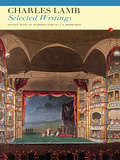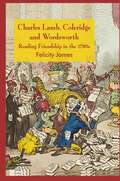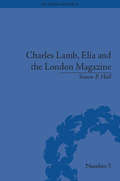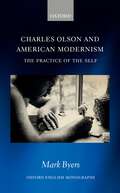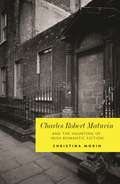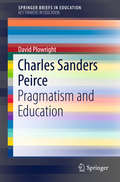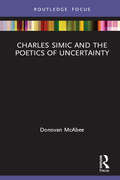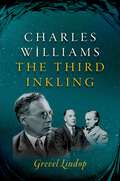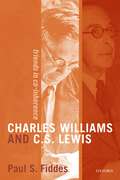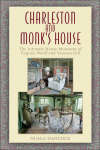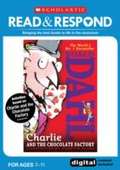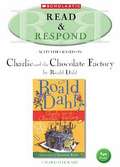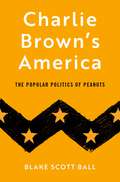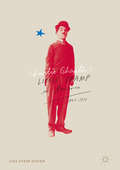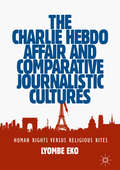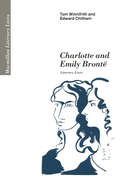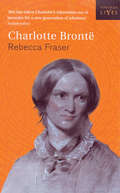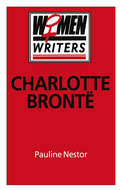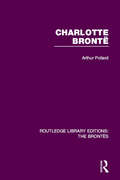- Table View
- List View
Charles Lamb: Selected Writings (Fyfield Bks.)
by Charles LambCharles Lamb (1775-1834), essayist, poet, humorist, critic and letter-writer, has an enduring reputation for his early "Tales from Shakespeare" (1807), written in collaboration with his sister Mary, and his " Essays of Elia," first published in the "London Magazine." This thematic selection of Lamb's writings - essays, dramatic criticism, verse and
Charles Lamb, Coleridge and Wordsworth: Reading Friendship in the 1790s
by Felicity JamesThis book makes the case for a re-placing of Lamb as reader, writer and friend in the midst of the lively political and literary scene of the 1790s. Reading his little-known early works alongside others by the likes of Coleridge and Wordsworth, it allows a revealing insight into the creative dynamics of early Romanticism.
Charles Lamb, Elia and the London Magazine: Metropolitan Muse (The History of the Book)
by Simon P HullThe inherent 'metropolitanism' of writing for a Romantic-era periodical is here explored through the Elia articles that Charles Lamb wrote for the London Magazine.
Charles Lamb, Elia and the London Magazine: Metropolitan Muse (The History of the Book #5)
by Simon P HullThe inherent 'metropolitanism' of writing for a Romantic-era periodical is here explored through the Elia articles that Charles Lamb wrote for the London Magazine.
Charles Olson and American Modernism: The Practice of the Self (Oxford English Monographs)
by Mark ByersThis volume situates the work of American poet Charles Olson (1910-1970) at the centre of the early post-war American avant-garde. It shows Olson to have been one of the major advocates and theorists of American modernism in the late 1940s and early 1950s; a poet who responded fully and variously to the political, ethical, and aesthetic urgencies driving innovation across contemporary American art. Reading Olson's work alongside that of contemporaries associated with the New York Schools of painting and music (as well as the exiled Frankfurt School), the book draws on Olson's published and unpublished writings to establish an original account of early post-war American modernism. The development of Olson's work is seen to illustrate two primary drivers of formal innovation in the period: the evolution of a new model of political action pivoting around the radical individual and, relatedly, a powerful new critique of instrumental reason and the Enlightenment tradition. Drawing on extensive archival research and featuring readings of a wide range of artists including, prominently, Barnett Newman, Mark Rothko, David Smith, Wolfgang Paalen, and John Cage, Charles Olson and American Modernism offers a new reading of a major American poet and an original account of the emergence of post-war American modernism.
Charles Olson and American Modernism: The Practice of the Self (Oxford English Monographs)
by Mark ByersThis volume situates the work of American poet Charles Olson (1910-1970) at the centre of the early post-war American avant-garde. It shows Olson to have been one of the major advocates and theorists of American modernism in the late 1940s and early 1950s; a poet who responded fully and variously to the political, ethical, and aesthetic urgencies driving innovation across contemporary American art. Reading Olson's work alongside that of contemporaries associated with the New York Schools of painting and music (as well as the exiled Frankfurt School), the book draws on Olson's published and unpublished writings to establish an original account of early post-war American modernism. The development of Olson's work is seen to illustrate two primary drivers of formal innovation in the period: the evolution of a new model of political action pivoting around the radical individual and, relatedly, a powerful new critique of instrumental reason and the Enlightenment tradition. Drawing on extensive archival research and featuring readings of a wide range of artists including, prominently, Barnett Newman, Mark Rothko, David Smith, Wolfgang Paalen, and John Cage, Charles Olson and American Modernism offers a new reading of a major American poet and an original account of the emergence of post-war American modernism.
Charles Robert Maturin and the haunting of Irish romantic Fiction
by Christina MorinA clear, theoretically-grounded, chronological study of Maturin’s six novels. A new critical paradigm by which to view and read Irish Romantic fiction. Offers the most comprehensive and up-to-date analysis of Maturin and his fiction available today.
Charles Sanders Peirce: Pragmatism and Education (SpringerBriefs in Education)
by David PlowrightThis book introduces a number of selected ideas from the work of Charles Sanders Peirce, the founder of pragmatism. Peirce, pronounced ‘purse’, was born in America in 1839 and died in 1914. He published little in his own lifetime and he continually struggled to become recognised as a respected author with ideas that were highly creative, original and unique. The book begins with an examination of Peirce’s life history. This is followed by an explanation of pragmatism, which states that an understanding of a concept can only be fully grasped by knowing what its practical effects are. The author then explains a number of Peirce’s ideas that are based on his pragmatic maxim: · scientific inquiry as a method of investigation and its relevance to everyday thinking· inferential thinking based on abduction, deduction and induction and its use in educational research· semiotics, the study of signs and its relevance to the development of conceptual understanding· his profound and insightful ontological categories of Firstness, Secondness and Thirdness and their application to developing an understanding of the world around usThis introductory text is written in a clear and accessible style. Numerous examples are used throughout the book to illustrate Peirce’s complex and sophisticated ideas and to show how his thinking can be applied to education.
Charles Simic and the Poetics of Uncertainty
by Donovan McAbeeCharles Simic and the Poetics of Uncertainty provides the first full account of the poetics of the former US Poet Laureate, who is one of the most popular and critically acclaimed English-language poets writing today. The book argues for uncertainty as the center of Simic’s poetics and addresses the ways that his poetry grows from and navigates various forms of uncertainty. Donovan McAbee addresses uncertainty regarding the national character of Simic’s poetry and how this is complicated by Simic’s identity as a Yugoslavian refugee to the United States. The book assesses the theological and linguistic uncertainties of Simic’s poetry and explores the ways that Simic articulates the aesthetic space created by poems, as a safe place of encounter for the reader. The book argues for the role of humor as a primary mode that holds together the uncertainties of Simic’s poetry, and finally, it articulates the way that within these uncertainties, Simic develops a deeply humane political poetry of survival. Along the way, Simic’s work is placed in conversation with key influences and other important American and international poets and writers, including James Tate, Mark Strand, Charles Wright, Nicanor Parra, Vasko Popa, and others.
Charles Simic and the Poetics of Uncertainty
by Donovan McAbeeCharles Simic and the Poetics of Uncertainty provides the first full account of the poetics of the former US Poet Laureate, who is one of the most popular and critically acclaimed English-language poets writing today. The book argues for uncertainty as the center of Simic’s poetics and addresses the ways that his poetry grows from and navigates various forms of uncertainty. Donovan McAbee addresses uncertainty regarding the national character of Simic’s poetry and how this is complicated by Simic’s identity as a Yugoslavian refugee to the United States. The book assesses the theological and linguistic uncertainties of Simic’s poetry and explores the ways that Simic articulates the aesthetic space created by poems, as a safe place of encounter for the reader. The book argues for the role of humor as a primary mode that holds together the uncertainties of Simic’s poetry, and finally, it articulates the way that within these uncertainties, Simic develops a deeply humane political poetry of survival. Along the way, Simic’s work is placed in conversation with key influences and other important American and international poets and writers, including James Tate, Mark Strand, Charles Wright, Nicanor Parra, Vasko Popa, and others.
Charles Williams: The Third Inkling
by Grevel LindopThis is the first full biography of Charles Williams (1886-1945), an extraordinary and controversial figure who was a central member of the Inklings—the group of Oxford writers that included C.S. Lewis and J.R.R. Tolkien. Charles Williams—novelist, poet, theologian, magician and guru—was the strangest, most multi-talented, and most controversial member of the group. He was a pioneering fantasy writer, who still has a cult following. C.S. Lewis thought his poems on King Arthur and the Holy Grail were among the best poetry of the twentieth century for 'the soaring and gorgeous novelty of their technique, and their profound wisdom'. But Williams was full of contradictions. An influential theologian, Williams was also deeply involved in the occult, experimenting extensively with magic, practising erotically-tinged rituals, and acquiring a following of devoted disciples. Membership of the Inklings, whom he joined at the outbreak of the Second World War, was only the final phase in a remarkable career. From a poor background in working-class London, Charles Williams rose to become an influential publisher, a successful dramatist, and an innovative literary critic. His friends and admirers included T.S. Eliot, W.H. Auden, Dylan Thomas, and the young Philip Larkin. A charismatic personality, he held left-wing political views, and believed that the Christian churches had dangerously undervalued sexuality. To redress the balance, he developed a 'Romantic Theology', aiming at an approach to God through sexual love. He became the most admired lecturer in wartime Oxford, influencing a generation of young writers before dying suddenly at the height of his powers. This biography draws on a wealth of documents, letters and private papers, many never before opened to researchers, and on more than twenty interviews with people who knew Williams. It vividly recreates the bizarre and dramatic life of this strange, uneasy genius, of whom Eliot wrote, 'For him there was no frontier between the material and the spiritual world.'
Charles Williams: The Third Inkling
by Grevel LindopThis is the first full biography of Charles Williams (1886-1945), an extraordinary and controversial figure who was a central member of the Inklings—the group of Oxford writers that included C.S. Lewis and J.R.R. Tolkien. Charles Williams—novelist, poet, theologian, magician and guru—was the strangest, most multi-talented, and most controversial member of the group. He was a pioneering fantasy writer, who still has a cult following. C.S. Lewis thought his poems on King Arthur and the Holy Grail were among the best poetry of the twentieth century for 'the soaring and gorgeous novelty of their technique, and their profound wisdom'. But Williams was full of contradictions. An influential theologian, Williams was also deeply involved in the occult, experimenting extensively with magic, practising erotically-tinged rituals, and acquiring a following of devoted disciples. Membership of the Inklings, whom he joined at the outbreak of the Second World War, was only the final phase in a remarkable career. From a poor background in working-class London, Charles Williams rose to become an influential publisher, a successful dramatist, and an innovative literary critic. His friends and admirers included T.S. Eliot, W.H. Auden, Dylan Thomas, and the young Philip Larkin. A charismatic personality, he held left-wing political views, and believed that the Christian churches had dangerously undervalued sexuality. To redress the balance, he developed a 'Romantic Theology', aiming at an approach to God through sexual love. He became the most admired lecturer in wartime Oxford, influencing a generation of young writers before dying suddenly at the height of his powers. This biography draws on a wealth of documents, letters and private papers, many never before opened to researchers, and on more than twenty interviews with people who knew Williams. It vividly recreates the bizarre and dramatic life of this strange, uneasy genius, of whom Eliot wrote, 'For him there was no frontier between the material and the spiritual world.'
Charles Williams and C. S. Lewis: Friends in Co-inherence
by Paul S. FiddesThis study of the literary relationship between Charles Williams and C. S. Lewis during the years 1936-1945 focuses on the theme of 'co-inherence' at the centre of their friendship. The idea of 'co-inherence' has long been recognized as an important contribution of Williams to theology, and had significant influence on the thought of Lewis. This account of the two writers' conviction that human persons 'inhere' or 'dwell' both in each other and in the triune God reveals many inter-relationships between their writings that would otherwise be missed. It also shows up profound differences between their world-views, and a gradual, though incomplete, convergence onto common ground. Exploring the idea of co-inherence throws light on the fictional worlds they created, as well as on their treatment (whether together or separately) of a wide range of theological and literary subjects: the Arthurian tradition, the poetry of William Blake and Thomas Traherne, the theology of Karl Barth, the nature of human and divine love, and the doctrine of the Trinity. This study draws for the first time on transcriptions of Williams' lectures from 1932 to 1939, tracing more clearly the development and use of the idea of co-inherence in his thought than has been possible before. Finally, an account of the use of the word 'co-inherence' in English-speaking theology suggests that the differences that existed between Lewis and Williams, especially on the place of analogy and participation in human experience of God, might be resolved by a theology of co-inherence in the Trinity.
Charles Williams and C. S. Lewis: Friends in Co-inherence
by Paul S. FiddesThis study of the literary relationship between Charles Williams and C. S. Lewis during the years 1936-1945 focuses on the theme of 'co-inherence' at the centre of their friendship. The idea of 'co-inherence' has long been recognized as an important contribution of Williams to theology, and had significant influence on the thought of Lewis. This account of the two writers' conviction that human persons 'inhere' or 'dwell' both in each other and in the triune God reveals many inter-relationships between their writings that would otherwise be missed. It also shows up profound differences between their world-views, and a gradual, though incomplete, convergence onto common ground. Exploring the idea of co-inherence throws light on the fictional worlds they created, as well as on their treatment (whether together or separately) of a wide range of theological and literary subjects: the Arthurian tradition, the poetry of William Blake and Thomas Traherne, the theology of Karl Barth, the nature of human and divine love, and the doctrine of the Trinity. This study draws for the first time on transcriptions of Williams' lectures from 1932 to 1939, tracing more clearly the development and use of the idea of co-inherence in his thought than has been possible before. Finally, an account of the use of the word 'co-inherence' in English-speaking theology suggests that the differences that existed between Lewis and Williams, especially on the place of analogy and participation in human experience of God, might be resolved by a theology of co-inherence in the Trinity.
Charleston and Monk's House: The Intimate House Museums of Virginia Woolf and Vanessa Bell
by Nuala HancockThis compelling new study reveals, for the first time, through an emplaced investigation, the potential of Charleston and Monk's House to illuminate the shared histories of Virginia Woolf and Vanessa Bell.
Charlie And The Chocolate Factory (Read And Respond Ser. (PDF))
by Eileen Jones<i>Read & Respond</i> has been fully updated with new content. It provides teachers with a wealth of resources to teach <i>Charlie and the Chocolate Factory</i>. Notes and activities reflect the changes in the new Curriculum and include shared texts, guided reading notes, reading activities, speaking and listening activities, writing projects and assessment guidance. The CD-ROM contains interactive activities. Chocolate rivers and toffee trees... Magic is on the menu in Roald Dahl's tastiest book!
Charlie and the Chocolate Factory Teacher Resource (Read And Respond Ser.)
by Charlotte Raby Rupert Wyk*Now fully in line with 2014 Curriculum objectives* Raise literacy and attainment through a deep and active reading of a best-loved children's story by a major author. The 'Read & Respond' series takes growing readers into the heart of over 70 timeless stories, chosen to inspire reading for pleasure. Each teacher resource book focuses on a popular children's story, bringing it alive in a cross-curricular way. Explore every facet of the story through speaking and listening activities, debate and discussion, guided reading, creative writing, quizzes, games and crafts. This teacher resource book contains everything you need to share 'Charlie and the Chocolate Factory' with your class: * Plot, character and setting activities * Speaking and listening activities * Guided and shared reading sessions * Extended writing projects * Differentiation and assessment ideas * Photocopiable activity pages.
Charlie Brown's America: The Popular Politics of Peanuts
by Blake Scott BallDespite--or because of--its huge popular culture status, Peanuts enabled cartoonist Charles Schulz to offer political commentary on the most controversial topics of postwar American culture through the voices of Charlie Brown, Snoopy, and the Peanuts gang. In postwar America, there was no newspaper comic strip more recognizable than Charles Schulz's Peanuts. It was everywhere, not just in thousands of daily newspapers. For nearly fifty years, Peanuts was a mainstay of American popular culture in television, movies, and merchandising, from the Macy's Thanksgiving Day Parade to the White House to the breakfast table. Most people have come to associate Peanuts with the innocence of childhood, not the social and political turmoil of the 1960s and 1970s. Some have even argued that Peanuts was so beloved because it was apolitical. The truth, as Blake Scott Ball shows, is that Peanuts was very political. Whether it was the battles over the Vietnam War, racial integration, feminism, or the future of a nuclear world, Peanuts was a daily conversation about very real hopes and fears and the political realities of the Cold War world. As thousands of fan letters, interviews, and behind-the-scenes documents reveal, Charles Schulz used his comic strip to project his ideas to a mass audience and comment on the rapidly changing politics of America. Charlie Brown's America covers all of these debates and much more in a historical journey through the tumultuous decades of the Cold War as seen through the eyes of Charlie Brown, Lucy, Linus, Peppermint Patty, Snoopy and the rest of the Peanuts gang.
Charlie Brown's America: The Popular Politics of Peanuts
by Blake Scott BallDespite--or because of--its huge popular culture status, Peanuts enabled cartoonist Charles Schulz to offer political commentary on the most controversial topics of postwar American culture through the voices of Charlie Brown, Snoopy, and the Peanuts gang. In postwar America, there was no newspaper comic strip more recognizable than Charles Schulz's Peanuts. It was everywhere, not just in thousands of daily newspapers. For nearly fifty years, Peanuts was a mainstay of American popular culture in television, movies, and merchandising, from the Macy's Thanksgiving Day Parade to the White House to the breakfast table. Most people have come to associate Peanuts with the innocence of childhood, not the social and political turmoil of the 1960s and 1970s. Some have even argued that Peanuts was so beloved because it was apolitical. The truth, as Blake Scott Ball shows, is that Peanuts was very political. Whether it was the battles over the Vietnam War, racial integration, feminism, or the future of a nuclear world, Peanuts was a daily conversation about very real hopes and fears and the political realities of the Cold War world. As thousands of fan letters, interviews, and behind-the-scenes documents reveal, Charles Schulz used his comic strip to project his ideas to a mass audience and comment on the rapidly changing politics of America. Charlie Brown's America covers all of these debates and much more in a historical journey through the tumultuous decades of the Cold War as seen through the eyes of Charlie Brown, Lucy, Linus, Peppermint Patty, Snoopy and the rest of the Peanuts gang.
Charlie Chaplin’s Little Tramp in America, 1947–77
by Lisa Stein HavenThis book focuses on the re-invigoration of Charlie Chaplin’s Little Tramp persona in America from the point at which Chaplin reached the acme of his disfavor in the States, promoted by the media, through his departure from America forever in 1952, and ending with his death in Switzerland in 1977. By considering factions of America as diverse as 8mm film collectors, Beat poets and writers and readers of Chaplin biographies, this cultural study determines conclusively that Chaplin’s Little Tramp never died, but in fact experienced a resurgence, which began slowly even before 1950 and was wholly in effect by 1965 and then confirmed by 1972, the year in which Chaplin returned to the United States for the final time, to receive accolades in both New York and Los Angeles, where he received an Oscar for a lifetime of achievement in film.
The Charlie Hebdo Affair and Comparative Journalistic Cultures: Human Rights Versus Religious Rites
by Lyombe EkoThe Charlie Hebdo terrorist attack of January 7, 2015 shook French journalism to the core and reverberated around the world, triggering a cascade of responses from journalists, media outlets, cartoonists and caricaturists from diverse geographies of freedom of expression and journalistic cultures. This book is a multifaceted case study that describes and explains sameness and difference in diverse journalistic conceptualizations of the Charlie Hebdo affair from a comparative, international perspective. It explores how different journalistic traditions, cultures, worldviews and styles conceptualized and reacted to the clash between freedom of expression and respect for religious sentiments in the context of terrorism, where those sentiments are imposed on the media and secular societies through intimidation, coercion and violence. The book analyzes the political and cultural clashes between the core human right of freedom of expression, and rite of respect for religious sentiments, which is situated on the outer periphery of the human right of freedom of religion. It also examines how media outlets, editors, and cartoonists from different politico-cultural contexts and journalistic cultures in Africa, Asia, Europe, the Middle East, and North and South America, addressed the delicate issue of Mohammed cartoons in general, and the problem of (re)publication of the controversial Charlie Hebdo Je Suis Charlie Mohammed cartoon, in particular.
Charlotte and Emily Brontë: Literary Lives (Literary Lives)
by Edward Chitham Tom WinnifrithThis new book on the Brontes concentrates on the way in which the literary interests and expressions of Charlotte and Emily were built up. It makes use of recent research into background and reading matter to investigate the development of the authors' poetry and novels.
Charlotte Bronte: Charlotte Bronte And Her Family (Vintage Lives #3)
by Rebecca Fraser'If men could see us as we really are, they would be amazed', wrote Charlotte Brontë, the outwardly conventional parson's daughter who had rarely met any men beyond those of the church or classroom by the time Jane Eyre was published in 1847. From the landscape of the Yorkshire moors, an appalling childhood and a family decimated by consumption, Jane Eyre came as an instant literary sensation. It also brought Charlotte Brontë the notoriety that was to remain with her for the rest of her short and tragic life. Elizabeth Gaskell, Charlotte's first biographer, attempted to clear Charlotte of the charges of passionate immorality that were levelled at a woman author - and an unmarried one at that. Rebecca Fraser, 130 years later, placed Charlotte's life within the perceptual framework of contemporary attitudes to women. Her biography is an invaluable contribution to Brontë scholarship, which shares her admiration for a woman prepared to stand out against some of the cruelest Victorian ideas about her sex.
Charlotte Brontë (Routledge Library Editions: The Brontës)
by Arthur PollardWithin the narrow confines of Haworth Parsonage the Brontë children constructed a multiform fantasy world and to their gift of intense imagination was added the quality of intense passion. The narrowness of Charlotte’s experience makes autobiography important in her novels, while her imagination and passion exalt the subjectivity of her work. Her style is autobiographical also, adding credibility to the often heightened narrative, while the moralism of her heroines often serves to stabilise this exaggeration. This book, first published in 1968, introduces extracts from the novels of Charlotte Brontë, emphasising the author’s subjectivity, imagination and the resultant heightening of dialogue and experience. There is a central section on her heroines, while others discuss and illustrate events, other characters, the handling of time and place, speech and dialogue and the author’s place in novels. This title will be of interest to students of English Literature.
